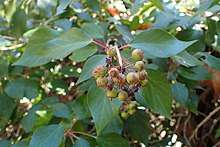Hedera pastuchovii
Hedera pastuchovii, is a species of ivy (genus Hedera) which is native from Eastern Transcaucasus. It is a plant of botanical family Araliaceae. It is in The Red Book of Azerbaijan SSR, 1989.
| Hedera pastuchovii | |
|---|---|
 | |
| Scientific classification | |
| Kingdom: | Plantae |
| Clade: | Tracheophytes |
| Clade: | Angiosperms |
| Clade: | Eudicots |
| Clade: | Asterids |
| Order: | Apiales |
| Family: | Araliaceae |
| Genus: | Hedera |
| Species: | H. pastuchovii |
| Binomial name | |
| Hedera pastuchovii Woronow | |
It is an evergreen woody vine with long climbing stems, growing in mixed forests to 20–30 m high where suitable trees, are available, does not grow well as a groundcover plant. It climbs by means of aerial rootlets which cling to the substrate.
Leaves thin, glossy, light green, entire or with wavy margins, 10–12 cm x 6–9 cm, often rounded and rarely oblong-elliptic, deeply or shallowly lobed, cordate or cuneate at the base.
A rare relict species of the Greater Caucasus (Balakan, Zagatala, Gakh, Sheki and Khachmaz regions), Talysh (Astara, Lankaran, Masalli regions). Outside Azerbaijan - Eastern Transcaucasia, Iran. Habitat in the forests of the lowlands up to the middle mountain zone mainly on the forest edges and clearings, climbs high on the trees, does not crawl along the rocks. It is protected in the Zakatala and Girkan reserves. A preserve is being set up in the Samur River's delta (the Khachmaz region) for wider cultivation to protect the lowland riparian woodlands.
In cultivation in the UK the cultivar ‘Ann Ala’ has gained the Royal Horticultural Society’s Award of Garden Merit.[1][2]
Hedera Pastuchovii Woronow, commonly known as the "Russian Ivy", is part of the family of Araliaceae due to the area in which it is found and used.
Hedera Pastuchovii G Woronow has a chromosome number of 2n= 144 (6x), making it a hexaploid. The distribution of the plant varies around the content of Asia, but it is native to the Caucasus, Elburz Mountains of Iran. In a recent study of phylogenetics, H. Pastuchovii, has been found to be related to other species of parsimony through a test of cpDNA restriction site variation analysis. In the clade containing Asian taxa, the results showed that the pre-existing phylogenies are largely congruent to one another, helping to place one additional clade helped resolve the positions of H. maroccana, H. iberica, and H. canariensis in the combined analysis.[3]
Hedera Pastuchovii is a climbing plant that can be found on many trees or walls, as it clings up to any surface and is good for climbing or scaling any walls or trees.
References
- "RHS Plantfinder - Hedera pastuchovii 'Ann Ala'". Retrieved 3 March 2018.
- "AGM Plants - Ornamental" (PDF). Royal Horticultural Society. July 2017. p. 45. Retrieved 2 March 2018.
- Ackerfield, Jennifer; Wen, Jun (July 2003). "EVOLUTION OF HEDERA (THE IVY GENUS, ARALIACEAE): INSIGHTS FROM CHLOROPLAST DNA DATA". International Journal of Plant Sciences. 164 (4): 593–602. JSTOR 10.1086/375423.